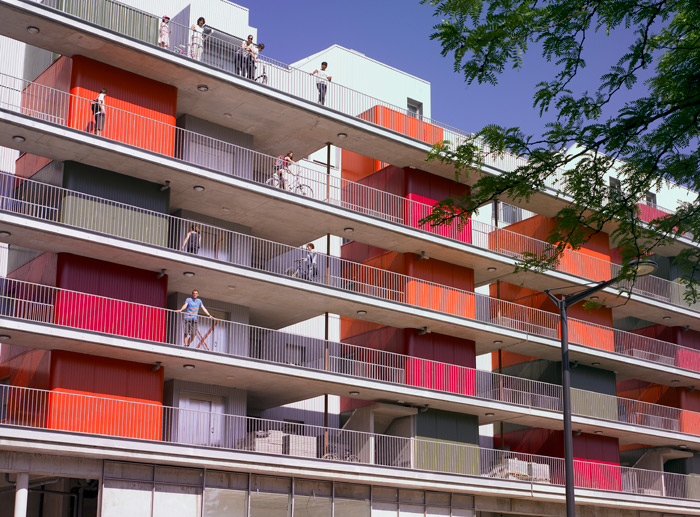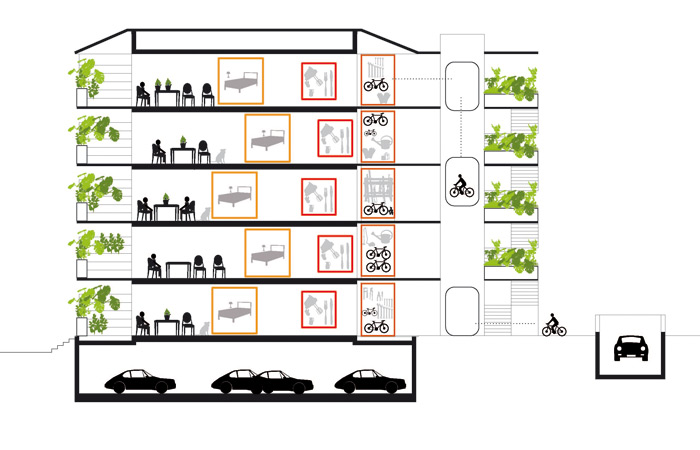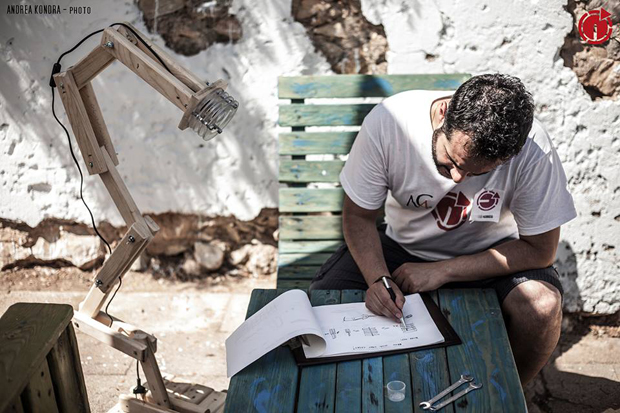Hoy ponemos a la descarga el Boletín de Noticias URBACT del mes de agosto de 2013: [Download not found] continue reading
Archive for August, 2013
August 23, 2013
August 9, 2013
Today we introduce Matthieu Darcourt, an architecture student who has been doing a short internship with us, bringing the French language back to the office after a couple of years… Here is what he tells us:
I’m a student in architecture at the National Institute of Applied Sciences (INSA) of Strasbourg in France, and I will graduate in October 2014. I had the opportunity to travel a lot especially during my Erasmus in Budapest and my internship here at ecositema urbano in Madrid. I believe there is no such thing as losing yourself in an unknown city in order to discover it’s deeper essence, culture and personality. As an architect and as a person, I am really interested in this balance between big cities and traditional culture, and Madrid is a beautiful example of it: a 21st century city with a village atmosphere.
During my internship at ecosistema urbano, I had the chance to think about it when writting an article about situationist theories and urban participation. Indeed, thanks to their blog, they take some time to think and research concerning urban social design, so it creates a stimulating and creative atmosphere and projects. I found really interesting the original project approach they have, including social networks, technologies, and creative commons, questioning urban landscape and social life. Finally, I enjoyed the nice atmosphere of the studio, especially during cooking time! Thanks again.
Occupation: Architecture student
Interests: Architecture, Anthropology, Sculpture, Cities
City/country: Strasbourg, FR
Web: Portfolio
August 8, 2013
Los buenos servicios urbanos son más importantes que los eventos públicos
En la antigua Roma, las masas se mantenían calmadas gracias al pan gratis y el atroz espectáculo del Coliseo. Ahora son el Comité Olímpico Internacional (COI) y la Federación Internacional de Fútbol Asociación (FIFA) quienes juegan este papel.
Sin embargo, mientras Erdogan parece haber perdido toda popularidad con la decisión de arrasar el parque Gezi con otro centro comercial, los eventos en Brasil muestran que los servicios urbanos son en realidad más valorados que los espectáculos.
El urbanismo al frente
En ambos casos, la cuestión de la planificación urbana ha saltado al frente, quedando en primera línea de debate. Estambul es una de las ciudades de mayor crecimiento del mundo, con una población de más de 20 millones de habitantes. Sin embargo, tiene pocos espacios abiertos, e incluso éstos están en peligro por el modelo de desarrollo del sector privado. Las manifestaciones comenzaron a raíz de la propuesta para sustituir el parque Gezi por un centro comercial. continue reading
August 7, 2013
How can urban design solve the complex situation that takes place in street junctions where bikes, pedestrians and motorists have to cross and turn in different directions? This interesting video shows one of the typical Dutch solutions to this problem.
Could this be implemented everywhere? While other places are going for mixed use of the street (like Spanish ciclocalles) or even more radical solutions like shared space or even ‘naked streets’ without any signs or lights, cities in the Netherlands are known for making extensive use of segregated bike lanes, and that is the scenario where this kind of solution makes sense. There are also other types of intersections, like the roundabouts, which can solve the same problem in a different way.
It’s worth noting how helpful the video format is for explaining this kind of dynamic issues in the city. I also recommend reading the discussions under the posts linked below; you will find interesting opinions and alternatives.
Read more:
August 6, 2013
Today we introduce Claudio Marras, a young architect who is doing an internship with us, taking part in various aspects of our work… and also bringing a great Italian touch to our lunchbreak! Let him tell us a couple of things about himself:
A young dreamer architect.
Passion, Curiosity and Perseverance: I want to travel, I want to see, I want to know.

Architect evolution
Hello everybody, I am Claudio Marras a 30 years old italian architect come from Sardinia, Italy. I will try to synthesize my life with 3 simple keywords.
Passione (passion)
From from child to young adult
A life lived wrapped by passion. Food, travel, sport, people, ART… Born in a creative and art-loving family, I was easily able to discover and explore different worlds. Living in a island I had, from the beginning, the pleasure (and necessity) to go abroad.
I lived in Croatia, Usa, Spain and Germany and I traveled throughout most of Europe.
Curiositá (curiosity)
From external world to myself
Each place/person could teach you something. It’s up to you understand the way to acquire knowledge from it. Every place can be different for everyone, it’s the culture and meaning behind it that matters and makes it special and unique for every one. It is not only the place, it is also the experience.
As an architect I have to design the space in relation with local dynamics and needs, trying to involve those who will use that space into the process.
Determinazione (perseverance)
From Valencia to Punto d’Incontro

Different forms of urban attraction.
The Turia’s park of Valencia for a cultural conversion of spare time
Social Architect
My architecture thesis project (2007) was the synthesis of my mindset and my professional way of seeing urbanism and architecture: bottom up architecture, social approach, participatory process. The project’s AIM was to find a social and cultural way to convert the spare time of the people. The idea was to give to everyone the opportunity to know and exchange skills and competencies in a public space coordinated by the Time-based currency system. The project was studied for the river park of Valencia, Spain.
Starting from these theoretical input, I’m developing it in a practical way trough Punto d’incontro (Meeting point) project. It is a box that contains active and creative groups or people who work for the re-appropriation of public space through a participatory process. Artists, professionals, and experts interact with the local population to involve people in a urban renewal.
RESUME
Education
Bachelor Degree of Territorial, Urban and Environmental Planning in 2005.
Master Degree on Architecture in 2007.
Freelance architect from 2009 with a Certificate of Site Safety Coordinators (2012).
Currently a Post-Master student of Urban Research Lab Sardinia – Environmental Design in the University of Sassari (Sardinia) in partnership with Dessau Institute of Architecture (DIA) of Anhalt University of Applied Sciences where I spend the first part of the Master (5 moths).
more information on LinkedIn profile
In tempi come questi la fuga è l’unico mezzo per mantenersi vivi e continuare a sognare.
In times like these, escape is the only way to stay alive and keep dreaming.
Henry Laborit, from the italian movie: Mediterraneo
Here is a short summary about Claudio:
 Occupation: Freelance Architect
Occupation: Freelance Architect
Interests: urbanism, architecture, design, social, community
City/country: Sassari, Italy
Web: Punto d’Incontro
Online profiles: Facebook, LinkedIn
August 5, 2013
Cities, organizations increasingly vast and uncontrolled, crystallize today most social and environmental issues. Intensification is a hot topic as antidote to urban sprawl and overconsumption of the territory, but how to live in the dense city, make it livable and desirable? This paradox between individual aspirations and the need to contain the growth of cities is a challenge for the architecture, the opportunity to imagine new types of habitats, for the collective economy of the soil, but offer a sense of independence and freedom in the use of space, from within and without.
Let’s find a simple example: to reduce private car use, many cities are trying to promote green transport methods, including cycling, which is highly valued by the local population that exhibits a strong “scientific, sporty and green” image. The cycle path network is growing, but the problem lies at the two ends: What do you do with your bike when you get to your destination?
The bicycle is the most efficient form of transportation ever devised, and it delivers a whole-body workout. Cycling consumes far fewer calories per mile travelled than cars, buses, or even walking. It is sometimes the fastest way to get around a city. Cyclists can zip around traffic jams and don’t have to fight for a parking spot because they can bring the vehicle home… maybe: Many homes aren’t bicycle-friendly, so bikes are either not used or not purchased.
The French architectural studio ‘HERAULT ARNOD architectes’ was faced with that problem in Grenoble, where they designed a sustainable residential house.

Image is made by Herault Arnod architectes | L’IMMEUBLE À VÉLOS |Grenoble 2006-2010
The project ‘Bike building’ has a system which makes possible to take one’s bike to the door of one’s apartment. The lifts are big enough to carry bikes; the corridors are wide and form a panoramic walkway with views over the mountains. People enter their homes as they would a house, from the outside. The architecture of the storage and distribution system is designed for a project situated at the end of the cycle path network. People will be able to reach their front doors on rollerblades, scooters, bicycles, etc., and then store their wheels in a safe place.
‘…This project was conducted as part of an order placed by the architects to 8 City of Architecture and Heritage, on the theme of a “Habitat densified environmentally responsible.” These projects were gathered in one part of the traveling exhibition “Living Green”, which was provided by the police Gauzin-Dominique Müller, and which was presented to the City of Architecture…’ say Chris Younes and Isabel Herault
Since the outskirts of Grenoble are layered with districts of detached houses which generate traffic flows that grow more intense and more extensive each day, it is time to think about urban housing that is more in tune with contemporary aspirations. What does a detached house have that an apartment does not? Amongst other characteristics, we identified the relationship with the exterior, which is more direct and special, the greater privacy, and storage capacity: according to a recent study, 40% of the surface area in detached houses is used to store various objects, food, clothes, tools, bicycles, windsurfers, skis, etc.
‘…>80% of the population would rather live in a detached house than in an apartment block in town. What does a detached house have that an apartment does not? Amongst other characteristics, we identified the relationship with the exterior, which is more direct and special, the greater privacy, and storage capacity: according to a recent study, 40% of the surface area in detached houses is used to store various objects, food, clothes, tools, bicycles, windsurfers, skis, etc….’ say Chris Younes and Isabel Herault
The façade on the street side is made up of several layers which reveal the building’s unusual design, and make a feature of it through the system of outdoor corridors and the individual storage “boxes” placed in front of each apartment: the image is created by usage. People enter their apartments via a private balcony. Located between the walkway and the building’s main structure are the storerooms and bathrooms, which alternate with empty spaces running the whole height of the building. The “storage units” are clad with different coloured corrugated steel sheet, which individualize the apartments and together create an expansive, dynamic and contrasted façade – an unpatented and lively composition.
This project is not the only one example of bike-friendly houses designed by Herault Arnod architectes.
’24 apartments house’ project is located on a new BIA to Green Island, an eclectic neighbourhood of Grenoble composed of villas, workshops and small buildings on the banks of the Isere. It meets the certification BBC with 40% renewable energy, according to the requirements of the specifications of the ZAC. The building was designed to allow residents to live in the city as a house, with a privileged relationship to the outside. The twenty four units are through and have a large terrace facing west continues. Ends of the apartments have a triple orientation. All are served by an outdoor walkway sheltered east side. The building is intended to facilitate the use of bicycles in everyday life: each unit has a storage room, protected by winks perforated (over 50% vacuum), in which residents can store several bikes. The elevator is generously proportioned to allow everyone to borrow his bike.

Image is made by Herault Arnod architectes | 24 APARTEMENTS |Grenoble 2011-2013
The building is very compact, its organization to optimize the stairwell and the elevator are grouped in a separate volume, which they are connected by a walkway. This volume is wrapped in open vegetation: a linear bins, equipped with an automatic watering, home to vines that invade gradually cables and nets stretched between floors.
The other example of bicycle friendly building is the EcoFlats mixed-use apartment building, along North Williams Avenue in Portland with its co-developer, Jean-Pierre Veillet of Siteworks Design Build.
Williams Avenue, once the heart of a thriving African American community, is today well known as a popular bike route as well as a burgeoning retail area of restaurants, cafes and shops.
Image is made by Jean-Pierre Veillet | the Eco-flats |
On the ground floor of the building, for example, is Hopworks Bike Bar.
“Some 3,000 riders a day pass by Mr. Ettinger’s new brewpub,” the New York Times’ Linda Baker writes of Hopworks in a recent feature about the neighborhood and catering to cyclists. “It has racks for 75 bicycles and free locks, to-go entries that fit in bicycle water-bottle cages, and dozens of handmade bicycle frames suspended over the bar areas.”
There are no automobile parking spaces for tenants, but the 18-unit building has storage for 30 bikes.
“Cyclists are a great potential market for businesses that want people traveling at human-scale speed and will stop and buy something,” Roger Geller, the city’s bicycle coordinator, also told Baker.
Eco Flats is one of 15 building projects aiming toward net-zero operations through a pilot program launched in 2009 by Energy Trust of Oregon. Co developed by Doug Shapiro, it was designed to use approximately 60 percent less energy than a building constructed to code stipulations. Veillet says actual savings have been higher, approaching 80 percent. In the ground-floor entry to the apartments via elevator, a flat-screen TV affixed to the upper wall conveys in real-time the amount of energy being used by each unit as well as how much energy is being generated by a rooftop array of solar panels.
If you decided to become bike user, but the house you live in is not bicycle friendly, try to make your home bicycle friendly by yourself. A bicycle doesn’t ask for much. It just needs a safe, dry spot away from thieves and vandals.
By the way, in a humorous note, there is also the opposite way: you can make your bike the main element and attach your house to it, as this man did for the Burning Man festival, or as seen in various creations involving a bike and a tiny home.
For further reading:
‘Bicycle friendly area’ – Design workshop at Auroville- PDF









